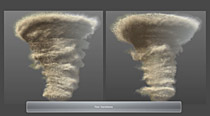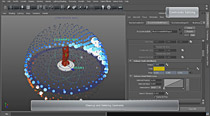 Technical Work |
 Flux Plugin by Morteza |
Believe it or not, there isn’t one button for lighting, one button for texturing, and two buttons for animating. Creating computer graphics requires an enormous amount of work, and some of it extremely technical. Although we usually only show the artistic side of CG on our web site, there is also a great deal of programming that goes into many of our projects. Although the technical clips above are by no means exhaustive, it will give you at least a taste of what we do.
The first clip titled Technical Work, shows some of the programming and simulation work which has gone into some of our recent commercials. Details of the Tornado programming can be found below:
| Description | Tornado System For Maya |
| Technology | C++, Maya API, MEL |
|
[ dnaTransferFluidAttributes ]: Transfers particle’s scalar and vector including customPP attributes to fluid containers within Add, Replace and Multiple modes. Interpolates data using linstep, smoothstep and hermite functions.
[ dnaTransformInterp ]: Interpolates transformation matrix between arrays of matrices [ dnaRampInfo ]: Maps array of attributes using curves In this example dnaTransferFluidAttributes was used to transfer particles’ attributes from tornado rig to fluid container; dnaTransformInterp was used to interpolate surface between main controllers (Stretchy Setup) and dnaRampInfo was used to add extra details to the surface of tornado. |
|
In the second clip, Flux Plugin, you will see a huge personal project from Morteza, showcasing his latest plugin, which deals with approximate image based lighting for Maya. Having noticed that nothing like this existed in the current market, Morteza decided to start development on his own full featured plugin. Flux is the result of his efforts. This plugin will be available for download from his web site at www.cgdna.com/web/flux in the near future. The in-depth details of the Flux Plugin can be found below:
| Description | FLUX: An approximate image based lighting tool for Maya |
| Technology | C++, Maya API, MEL, Boost, OpenGL, OpenMP, OpenExr |
|
Main Features: – Less Noise in Render – Less Render-time – Editable and Keyable – Precise Control over the result – Ideal for lighting Fur, Hair, Fluids and matching lights with Live action – Combines and interpolates multiple sets of HDRI – Pipeline friendly; Exports centroids data to Maya’s native data structure – Artists friendly; Customized “Attribute Editor Templates” for easy node connection and traversal – Fast and responsive; Multi-threaded and accelerated using built-in kdTree – Interactive modification of lights properties – Output statistics, verbose, diagnostic data Flux Pipeline: Stage (1) – Importing data Stage (2) – Pre-processing Stage (3) – Centroids Generation Stage (4) – Visualizing Stage (5) – Centroids Editing Stage (6) – Exporting data |
|





